French New Wave films have always been influenced by the atmosphere in French society, and each New Wave film has consistently and effortlessly adapted to whatever new direction French culture went in. As certain political issues became more prominent and called for more attention, some of the New Wave directors used their renowned names to create films with strong political messages; Jean Luc-Godard was one of these directors, utilizing his film Tout va Bien, released in 1972, to deliver a specific message. Godard started filming Tout va Bien —which translates to “everything is fine”— in 1967, prior to the tumultuous French revolution in May of 1968, but was still greatly influenced by the revolutionary circumstances. The title is ironically humorous considering that during May 1968, everything was not fine.
The events in May ’68 started with the younger French generation becoming exasperated with their president Charles de Gaulle, who was highly conservative. Strikes advocating for more personal freedom first broke out among college campuses and were led by a majority of French college students. Eventually, sympathy strikes multiplied amongst factory workers, but they were also pushing for a change in working conditions, pay, and better employee benefits. The revolt became so bad at one point that de Gaulle had to secretly consult some of his military generals positioned in Germany —which almost seemed like a flee for safety for de Gaulle— and France’s economy abruptly halted. Despite how badly the strikes impacted everyday life, the unity, hope, and excitement that a change would come was enough to keep the fight going. As Martin Luther King Jr. once said, “A riot is the language of the unheard.” By the end of the month when the strikes ended, workers received higher pay, better working conditions, and de Gaulle resigned.
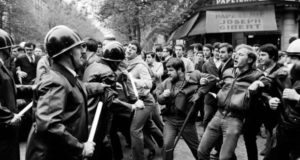
French college students in protest during May 1968.
Godard exercised methods classified under the overarching term “epic theater”, a theatrical movement created by Bertolt Brecht, a German playwright and theater director. However, each technique considered part of epic theater should not be seen as exclusive to the theatrical movement. That is to say, one of the methods included in epic theater involved breaking the fourth wall, but not every film that breaks the fourth wall is inspired by epic theater. Brecht contrived epic theater as the name for his plays that examined contemporary political issues. Because of the political messages in his plays, his motive was to distance the audience from the story to make sure they regularly saw the plot from an objective point of view and realized the theme out of rationality. Brecht did this through several methods such as montages, placing musical numbers into the plot, actors and actresses coming out of character, etc. Honestly, in my opinion, without the knowledge about epic theater, Tout va Bien seemed more like Godard simply wanted to film with a new creative medium, but now knowing the logical reasons behind the techniques in the film, the film’s message has a more complex meaning.
We see epic theater methods used in Godard’s film right off the bat with short clips and retakes of a scene that off-screen voices —presumably a writer and director— are still trying to figure out. This idea of a writer and director trying to fill in the gaps for a film’s plot is the foundation of Tout va Bien’s storyline. In other words, the film itself is supposed to be the visual representation of an initial idea between two creators as opposed to everything that happens in the movie already being a finished and completed idea before starting production. In the beginning, there are shots of the people, places, and things they come up with, but only appear according to when they are mentioned, and the people in each shot break the fourth wall. For instance, the two creators talk about there being a man and a woman in the plot, and there is a brief shot where both the man and the woman look directly at the camera while appearing to be in the middle of setting up for an unrelated scene.
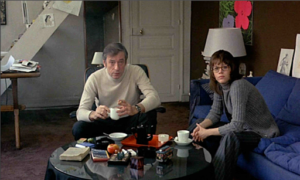
Her (Jane Fonda) and Him (Yves Montand) stare directly into the camera.
Much like a few of Alain Resnais’ films, such as Hiroshima Mon Amour (1959) or Last year at Marienbad (1961), that don’t give their characters names and instead go by “Her” and “Him”, Tout va Bien follows suit. However, in this case, the main couple is named “Her” and “Him” —played by Jane Fonda and Yves Montand— because the two creators are still in the beginning filmmaking process and simply don’t yet have names for them, rather than for ambiguity purposes like in Resnais’ films. When the story begins to gain more structure, we see that Fonda’s character works as an American radio journalist, and her husband, Montand’s character, is a French New Wave director.
Godard’s other methods from the epic theater movement included: musical numbers, rapid change in plot and setting, and a few characters whose monologues broke the fourth wall and talked about real facts regarding the French government, big business, or factory workers and their working conditions. Most of the film takes place in a sausage factory where all the workers went on strike and Fonda and Montand’s characters become hostages when they try to interview the manager at the factory, who was a hostage as well. A musical number soon breaks out about the strike, which helps remind the audience that the film is not based on reality. Godard also shows the set as if we were to see the entire sound stage, almost like looking into a dollhouse.
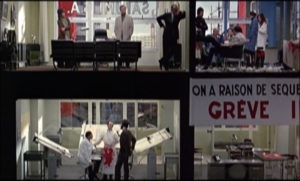
A scene where we see the set like a dollhouse.
Montad’s character has a vital monologue where he speaks directly into the camera, reflecting on his filmmaking about two-thirds of the way through the film. He tries to justify that making commercials is a modest job and he’s only making them to survive because he cannot keep making aesthetic films after what had happened in May ’68. Then, he reveals that while he felt like he knew everything about radicalism by taking part in the unity amongst the French workers, he realized that all of it was lost when he felt alienated after being held hostage by the same people he stood in solidarity with. The monologue ends, and he goes back to work filming his commercial. There is a long take of the camera screen that only shows the legs of the women who are modeling bright colored pantyhose —of which the commercial is about— but we are not shown the rest of the set that includes the dark background and tired workers like we are shown before the monologue. In short, while the director talks about experiencing what the majority of French workers were going through and said he understood the events of May ’68, he still believes that he was the victim when held hostage. This signifies that he does not understand the reason behind the events of May ’68 and in turn, revealed his complacency as part of the bourgeoisie. I think, in a sense, this monologue displays some of Godard’s feelings about other New Wave directors or possibly himself.
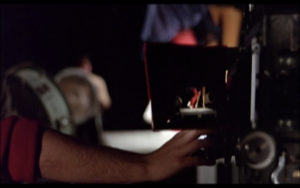
The shot of just the camera screen without seeing the actual working environment around the screen.
Tout va Bien also uses inter titles pigmented with the French flag colors and some of the inter titles are labeled like acts from a play. Separating the story into sections makes the film seem more like a play and, again, re-establishes the disconnect between Godard’s audience and the plot. Inter titles seem to be one of Godard’s favorite methods to pull the audience away from the story since he uses inter titles in many of his films, including Weekend (1967) and Masculin Féminin (1966). Godard’s mantra about making political films is, “The problem is not to make political films but to make films politically.” Tout va Bien certainly seemed to uphold that mantra. Instead of focusing on the film’s aesthetic and cinematic tendencies by creating a hyper-reality based on the political message, Godard reflected the political events by using film itself, displaying transparency about filmmaking and techniques that provided constant reminders that everything in the movie was actually part of a film. Thus, he successfully made his film politically, but not political.
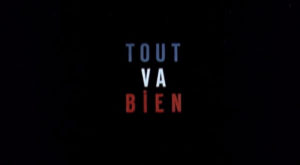
An inter title that says “Tout va Bien” in the French flag colors.
We have come full circle by starting the Nouvelle Vague journey with a Godard film and concluding the series with a Godard film. In fact, Tout va Bien was one of the last French New Wave films made. While Godard did make more films, the movement faded as directors that made their legacy from the French New Wave began to go down more personalized paths and implementing their own personal styles in their work by the late 1960’s. Even from Godard’s 1967 Weekend film to this one, you can see a more noticeable and consistent style between the two. Nonetheless, Godard was one of the major players in the film movement and will always be known for his radical political ideas, his challenging questions about human life, and generally, the lasting impact he created throughout the French New Wave.


Recent Comments